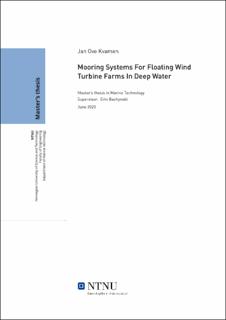| dc.contributor.advisor | Bachynski, Erin | |
| dc.contributor.advisor | Olsen, Gudmund Per | |
| dc.contributor.author | Kvamen, Jan Ove | |
| dc.date.accessioned | 2021-09-21T16:26:30Z | |
| dc.date.available | 2021-09-21T16:26:30Z | |
| dc.date.issued | 2020 | |
| dc.identifier | no.ntnu:inspera:54166542:52371958 | |
| dc.identifier.uri | https://hdl.handle.net/11250/2780089 | |
| dc.description.abstract | Verdas energibehov aukar stadig, samtidig som global oppvarming og stigande
temperaturar truar klima og miljø. Fornybare energikjelder må derfor utviklast.
Havvind er ein veksande teknologi som kan bidra til å løyse denne utfordringa.
Flytande vindturbinar kan bli brukt til å få tilgang til områder med store
energipotensiale, då dei kan operere på djupt vatn. Optimalisering av
forankringssystemet kan redusere den totale kostnaden til ein flytande vindturbin.
I forkant av forankringsdesign vart det gjort litteratursøk for å innhente
informasjon kring oppførselen til ein flytande vindturbin med tilhøyrande
forankringssystem, i tillegg til andre forankringssystem på djupt vatn. Vidare blei
bakgrunnsteori for design av vindturbinar og forankring studert. Simuleringar
av ein eksisterande modell, kalla OO-Star Wind Floater, blei gjennomført
i dataprogrammet SIMA. Denne modellen var på 130 m havdjup og nytta
vindturbinen DTU 10 MW Reference Trubine. Naturkreftene i simuleringane var
basert pa kondisjonar frå eit interessant områade utanfor kysten av California.
På grunn av begrensa datakapasitet blei resultata frå desse simuleringane brukt
til å lage ein forenkla modell av vindturbinen. Rotorblada blei bytta ut
med vindkoeffisientar og andre mindre justeringar blei gjort for å redusere
simuleringstida. Då samanlikninga av den opphavlege og den forenkla modellen
gav tilsvarande resultat, kunne den forenkla modellen bli brukt når dei nye
forankringssystema på 700 m havdjup skulle testast. To forankringssystem til éin
vindturbin, i tillegg til eit forankringssystem med ei delt forankringsline mellom
to turbinar, blei foreslått. Desse systema blei simulert i ulike operasjonelle og
ekstreme kondisjonar og resultata blei samanlikna og diskutert.
Ein av utfordringane ved forankring av vindturbinar på djupt vatn var
nødvendigheita av lange ankerliner. Likevel blei den estimerte totale kostnaden
av desse systema redusert samanlikna med eit kjettingsystem på 130 m havdjup
fordi polyester blei nytta som linemateriale. Samtlege designa forankringssystem
bestod testane gjennomført i ekstreme kondisjonar, basert på standardar frå DNV
GL. Resultata viste at både dei horisontale bevegelsane til vindturbinane, og
spenningane i ankerlinene var innanfor sine respektive restriksjonane.
Resultata frå simuleringane av forankringssystemet med ei delt line mellom to
turbinar gav dei største utslaga på horisontal bevegelse og linespenning. På grunn
av utfordringar med kopla bevegelsar var det vanskeleg å finne gode dimensjonar
på den delte lina. Dette er ein av fleire anbefalte forbetringar som bør undersøkast
nærmare ved vidare studie av dette prosjektet. | |
| dc.description.abstract | The worldwide energy demand is rapidly increasing. Simultaneously, global
warming and increasing temperatures threaten the environment. Therefore,
renewable energy sources must be developed. Offshore wind energy is a growing
technology and can be part of the solution to this problem. Floating offshore wind
turbines can be used to access areas with great potential, as they can operate at
large water depths. By optimizing the mooring system, the total cost of a floating
offshore wind turbine can be reduced.
Before designing new mooring systems, a literature review was done to acquire
information about the behavior of floating offshore wind turbines and their
mooring system, in addition to other mooring systems at deep water. The theory
regarding wind turbine and anchor design was also studied. Simulations of an
existing model called OO-Star Wind Floater was performed in SIMA. This model
was designed at 130 m water depth with the wind turbine DTU 10 MW Reference
Turbine. The environmental forces in the simulations were based on conditions in
an interesting area outside the coast of California.
Due to computational limitations, the results from these simulations were used to
make a simplified model of the wind turbine. The rotor blades were substituted
with wind coefficients, in addition to other minor adjustments, to reduce the
simulation time. The comparison between the initial and the simplified model
showed similar results. Therefore, the simplified model was used when testing
the designed mooring systems at 700 m water depth. Two mooring systems of a
single wind turbine, in addition to a mooring system with a shared mooring line
between two turbines, were suggested. These systems were simulated in different
operational and extreme conditions, and the results were compared and discussed.
When designing mooring systems of a wind turbine in deep water, long mooring
lines are necessary. However, the total cost was estimated to be reduced compared
to a chain mooring system at 130 m water depth because polyester was used as the
mooring line material. All designed mooring systems passed the test simulated in
extreme conditions based on standards from DNV GL. The results showed that the
horizontal offsets of the wind turbines and the tension in the mooring lines were
within their respective restrictions.
The simulation of the system with a shared mooring line resulted in the largest
horizontal offsets and mooring line tension. The coupled motion of the system
made it challenging to design the dimensions of this shared line. This is one of
the recommended improvements if further study of this project is to be performed. | |
| dc.language | | |
| dc.publisher | NTNU | |
| dc.title | Mooring Systems For Floating Wind Turbine Farms In Deep Water | |
| dc.type | Master thesis | |
